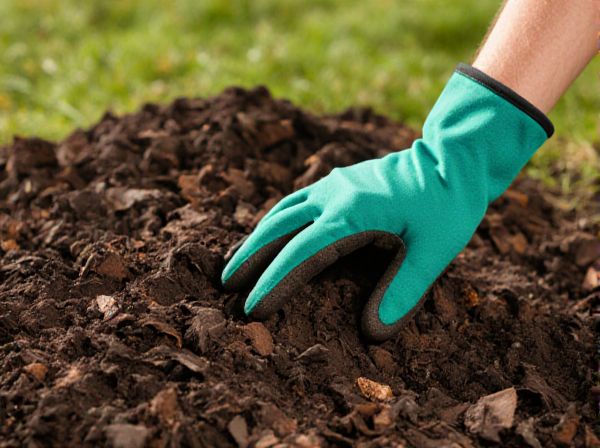
Sheet Mulching vs Tilling Illustration
Sheet mulching improves soil structure by layering organic materials directly on top of the raised bed, promoting moisture retention and weed suppression without disturbing soil life. Tilling, while effective for loosening compacted soil and incorporating amendments, can disrupt beneficial microorganisms and soil layers. Choosing sheet mulching over tilling supports sustainable soil health and long-term productivity in raised bed gardening.
Table of Comparison
| Feature | Sheet Mulching | Tilling |
|---|---|---|
| Soil Health | Enhances microbial activity, retains moisture, reduces erosion | Disrupts soil structure, reduces microbial diversity |
| Weed Control | Suppresses weeds using layered organic materials | Physically removes weeds but may promote regrowth |
| Labor Intensity | Moderate, involves layering materials | High, requires mechanical or manual turning |
| Impact on Soil Life | Supports earthworms and beneficial organisms | Can harm beneficial soil organisms |
| Long-term Sustainability | Promotes healthy, fertile soil over time | May degrade soil quality with repeated use |
| Suitable For | Raised beds, organic gardening, erosion-prone areas | Traditional gardening, soil loosening, immediate planting |
Introduction to Raised Bed Gardening
Raised bed gardening enhances soil structure and plant health by promoting better drainage and root growth. Sheet mulching fosters natural soil enrichment by layering organic materials, which suppresses weeds and conserves moisture without soil disruption. In contrast, tilling aerates the soil but can lead to erosion and disturb beneficial microorganisms essential for long-term garden vitality.
What is Sheet Mulching?
Sheet mulching is an organic gardening technique that builds soil health by layering materials like cardboard, compost, and mulch directly over the soil, suppressing weeds and enhancing moisture retention. This method stimulates beneficial microbial activity and improves soil structure without disturbing existing soil layers, unlike traditional tilling. Gardeners favor sheet mulching for its ability to create nutrient-rich, aerated soil while minimizing erosion and soil compaction in raised beds.
What is Tilling in Raised Beds?
Tilling in raised beds involves turning and breaking up the soil to improve aeration and nutrient distribution for plant roots. This process disrupts soil structure, which can lead to erosion and loss of beneficial microorganisms. Unlike sheet mulching, tilling requires more labor and can negatively impact long-term soil health in raised bed gardening.
Pros and Cons of Sheet Mulching
Sheet mulching enhances soil health by suppressing weeds, retaining moisture, and promoting beneficial microbial activity, making it ideal for raised beds with minimal soil disturbance. It reduces erosion and soil compaction compared to tilling but may require more initial materials like cardboard, compost, and mulch layers. However, decomposition rates can vary, potentially delaying planting timelines and necessitating careful moisture management to prevent fungal growth.
Pros and Cons of Tilling
Tilling aerates the soil, improves root penetration, and helps incorporate organic matter evenly, promoting robust plant growth in raised beds. However, excessive tilling can disrupt soil structure, reduce microbial activity, and increase erosion risk, potentially degrading soil health over time. Balancing tilling frequency with organic amendments supports sustainable raised bed gardening without harming beneficial soil ecosystems.
Soil Health: Sheet Mulching vs Tilling
Sheet mulching enhances soil health by promoting microbial activity, retaining moisture, and reducing erosion through organic layers that decompose naturally. In contrast, tilling disrupts soil structure, decreases beneficial organisms, and accelerates nutrient loss by exposing soil to air and sunlight. Consistently using sheet mulching supports long-term soil fertility and sustainability compared to conventional tilling methods.
Weed Control Comparison
Sheet mulching effectively suppresses weeds by blocking sunlight and creating a thick organic barrier, which decomposes into nutrient-rich soil, reducing the need for frequent maintenance. Tilling disrupts weed roots temporarily but can also bring dormant weed seeds to the surface, promoting new growth and requiring regular intervention. Raised beds combined with sheet mulching offer a sustainable weed control strategy by enhancing soil health and minimizing weed seed germination.
Impact on Soil Microorganisms
Sheet mulching preserves soil structure by maintaining a protective organic layer that fosters beneficial microorganisms, promoting nutrient cycling and improved soil health. Tilling disrupts soil aggregates and microbial habitats, causing a decline in microbial diversity and activity, which can lead to reduced soil fertility over time. Maintaining undisturbed soil environments through sheet mulching supports robust microbial communities essential for sustainable raised bed gardening.
Cost and Labor Analysis
Sheet mulching offers a cost-effective, low-labor alternative to traditional tilling by utilizing organic materials such as cardboard and mulch to suppress weeds and enrich soil naturally. Tilling requires significant labor and fuel expenses, potentially disrupting soil structure and beneficial microorganisms, which can lead to higher long-term maintenance costs. Choosing sheet mulching reduces the need for heavy equipment and ongoing labor, making it an efficient method for sustainable raised bed preparation.
Which Method is Best for Raised Beds?
Sheet mulching is the best method for raised beds as it improves soil structure by adding organic matter without disturbing beneficial microorganisms or soil layers. Tilling can disrupt soil ecology and lead to compaction and erosion, reducing long-term soil health in raised beds. Organic sheet mulch materials such as cardboard, compost, and straw provide nutrient-rich, weed-suppressing layers ideal for raised bed gardening.
Sheet Mulching vs Tilling Infographic

 gardendif.com
gardendif.com